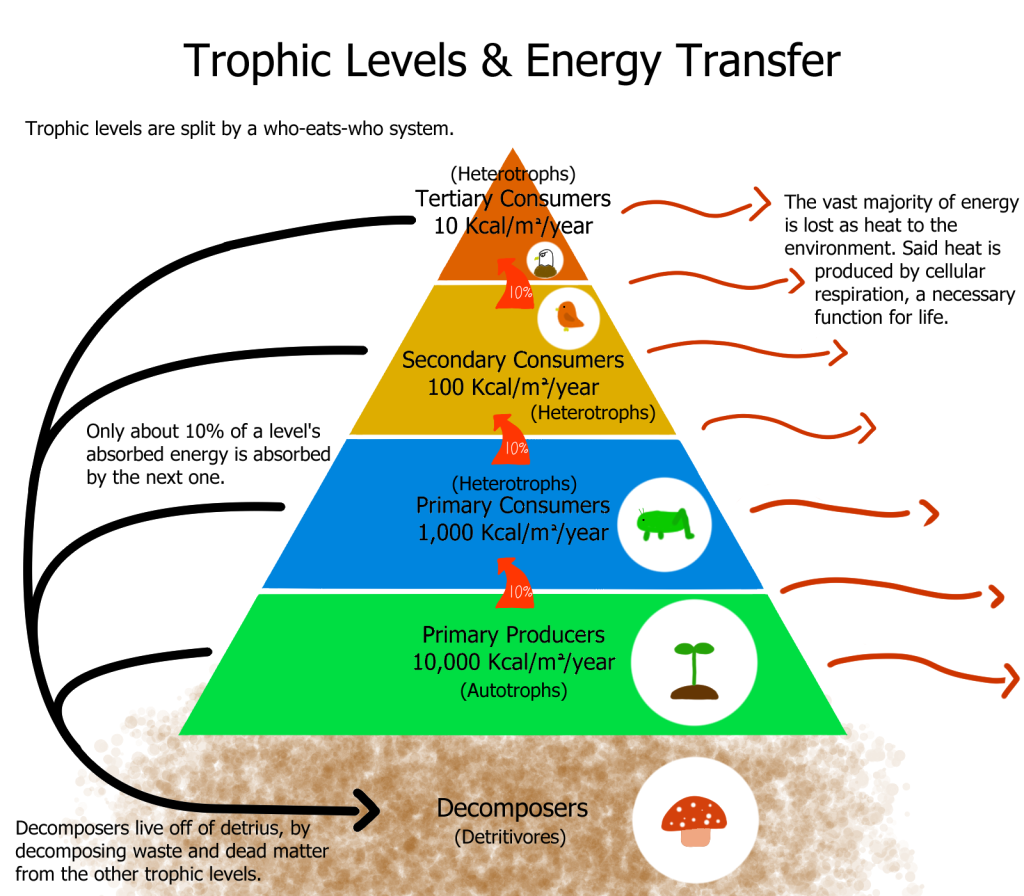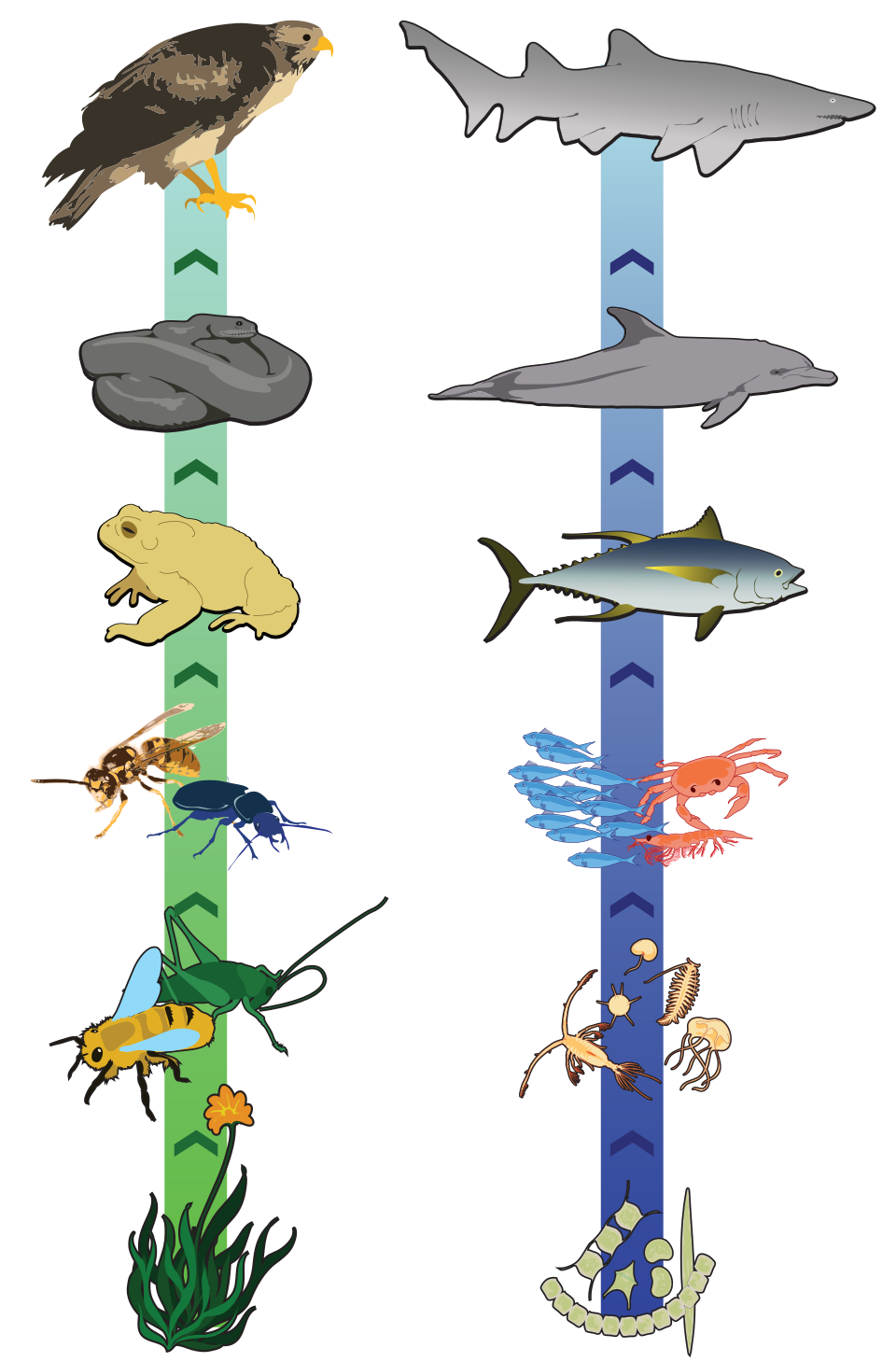IB Syllabus focus:
‘Net primary productivity is sustainably available plant growth for primary consumers; underpins food chains and sustainable harvests. Practice calculating GP and NP from data.’
Energy flow through ecosystems depends on how much plant growth is sustainably available for consumption. Net primary productivity (NPP) is the crucial base of all food chains.
Primary Productivity and NPP
Defining Productivity
Primary Productivity: The rate at which producers (mainly plants and algae) convert external energy and inorganic carbon into biomass through photosynthesis.
Primary productivity is expressed as biomass per unit area per unit time, typically kg C m⁻² yr⁻¹.
There are two stages:
Gross Primary Productivity (GPP): Total energy fixed by photosynthesis.
Net Primary Productivity (NPP): Energy remaining after plant respiration has been subtracted.
NPP and Its Equation
Net Primary Productivity (NPP) = Gross Primary Productivity (GPP) – Respiration (R)
NPP = Biomass available to consumers
Units: kg C m⁻² yr⁻¹
This energy forms the foundation of terrestrial and aquatic food chains. Without sufficient NPP, consumer populations cannot be sustained.

This diagram illustrates the flow of energy from producers at the base to higher trophic levels. Only a fraction of energy passes upward, so the energy available to consumers depends on producers’ net primary productivity (NPP). Labels are minimal and clear, aligned to IB ESS depth. Source.
The Role of NPP in Food Chains
Energy Availability
NPP is the base energy for primary consumers (herbivores) and thus indirectly supports higher trophic levels.
Sustainable harvests of crops, forests, and fisheries depend directly on maintaining or enhancing NPP.
Higher NPP generally means ecosystems can support greater biomass and biodiversity.
Differences Between Ecosystems
NPP varies significantly among ecosystems:
Tropical rainforests: Extremely high NPP due to abundant sunlight, water, and nutrients.
Deserts and tundra: Low NPP caused by limiting abiotic factors such as water scarcity or low temperatures.
Oceans: Although vast, most areas have relatively low NPP, with exceptions like coastal zones and upwelling regions where nutrients are abundant.
Calculating Productivity in Practice
Gross and Net Productivity
Gross Primary Productivity (GPP) is measured by the total photosynthesis rate.
Respiration (R) accounts for energy used by plants for metabolic processes.
Subtracting R from GPP provides NPP, the energy available for consumers.
Methods of Measurement
Laboratory experiments using controlled samples of photosynthetic organisms.
Field methods such as tracking biomass changes in vegetation over time.
Data logging technology allows continuous monitoring of light, CO₂, and oxygen to estimate productivity.
Sustainability and Human Use
NPP as a Limiting Factor
Human societies rely heavily on NPP:
Agriculture harnesses NPP through crop cultivation.
Forestry extracts NPP through timber and biomass harvests.
Fisheries depend on aquatic primary productivity for stock replenishment.
Overharvesting can reduce NPP below sustainable thresholds, leading to ecosystem degradation.
Maximum Sustainable Yield (MSY)
Closely tied to NPP, MSY represents the maximum amount of biomass that can be harvested without reducing long-term productivity.
Because NPP is the sustainably available plant growth, it naturally sets an upper limit on maximum sustainable yield (MSY) for herbivores and for human harvests.

A producer → consumer chain shows how energy captured by producers (via photosynthesis) becomes the food supply for herbivores and subsequently carnivores. The magnitude of this flow depends on NPP, which determines the energy entering the chain. Extra trophic-level labels beyond the producer–consumer link are not included, maintaining focus on syllabus scope. Source.
Energy Flow Through Trophic Levels
Importance of NPP at the Base
All higher trophic levels depend on the initial NPP pool.
Energy transfer is inefficient (often cited as the “10% rule”), meaning only a fraction of NPP becomes available at each subsequent level.
Shifts in NPP influence the carrying capacity of ecosystems.
Human Impacts on NPP
Deforestation reduces NPP by removing producers.
Climate change alters temperature and precipitation, changing ecosystem productivity patterns.
Fertiliser use can increase NPP artificially but often at the expense of nutrient cycling stability and ecosystem health.
Case for Sustainable Harvests
NPP as a Measure of Ecosystem Health
Monitoring NPP helps identify whether ecosystems are functioning sustainably. High or stable NPP usually signals resilience, while declining NPP often indicates environmental stress.
Application in Management
Agricultural planning seeks to maximise NPP while avoiding soil exhaustion.
Conservation efforts monitor NPP to detect ecological tipping points.
Global food security depends on maintaining or enhancing NPP under changing climate conditions.
Key Takeaways
NPP underpins food chains, providing the sustainable base for primary consumers and all higher trophic levels.
It is calculated by subtracting plant respiration from gross primary productivity.
Ecosystem productivity varies widely depending on abiotic factors.
Human activities directly affect NPP, making sustainable management crucial for ecological stability and resource security.
FAQ
In terrestrial ecosystems, NPP is mainly influenced by temperature, rainfall, and soil nutrient availability. Tropical rainforests show the highest values due to optimal conditions.
In aquatic ecosystems, light penetration and nutrient concentration are the main limiting factors. Coastal zones and areas of upwelling usually have far higher NPP than the open ocean.
GPP measures total energy fixed by photosynthesis but does not account for energy lost through respiration.
NPP provides a clearer picture of the actual energy available to consumers and is therefore a more accurate indicator of how much biomass an ecosystem can support.
Deforestation reduces producer biomass and lowers NPP.
Agriculture and fertiliser use may increase local NPP but often degrade soils and ecosystems long term.
Urbanisation converts productive land into areas with negligible NPP.
Tracking NPP helps reveal whether ecosystems are becoming more or less productive.
Declining NPP may indicate degradation, deforestation, or climate stress.
Stable or rising NPP suggests resilience or successful management practices.
Satellite data is often used for large-scale monitoring.
MSY depends on the biomass produced each year that can be harvested without reducing future productivity.
NPP sets the upper boundary of this available biomass because it represents the plant growth that can be consumed while maintaining ecosystem balance.
Practice Questions
Question 1 (2 marks)
Define net primary productivity (NPP) and explain its importance as the base of food chains.
Mark scheme
1 mark: Correct definition of NPP as gross primary productivity minus respiration.
1 mark: Explanation that NPP represents energy available to primary consumers and therefore underpins all higher trophic levels.
Question 2 (5 marks)
Discuss how variations in NPP between ecosystems influence their ability to support biodiversity and sustainable harvests.
Mark scheme
1 mark: Recognition that NPP varies across ecosystems (e.g., high in tropical rainforests, low in deserts/tundra).
1 mark: Explanation that higher NPP allows greater biomass and supports more species.
1 mark: Link between higher NPP and increased biodiversity.
1 mark: Connection between NPP and sustainable harvests (e.g., agriculture, forestry, fisheries).
1 mark: Understanding that low NPP limits both biodiversity and human exploitation potential.

